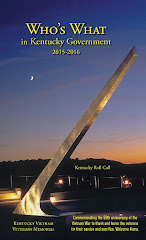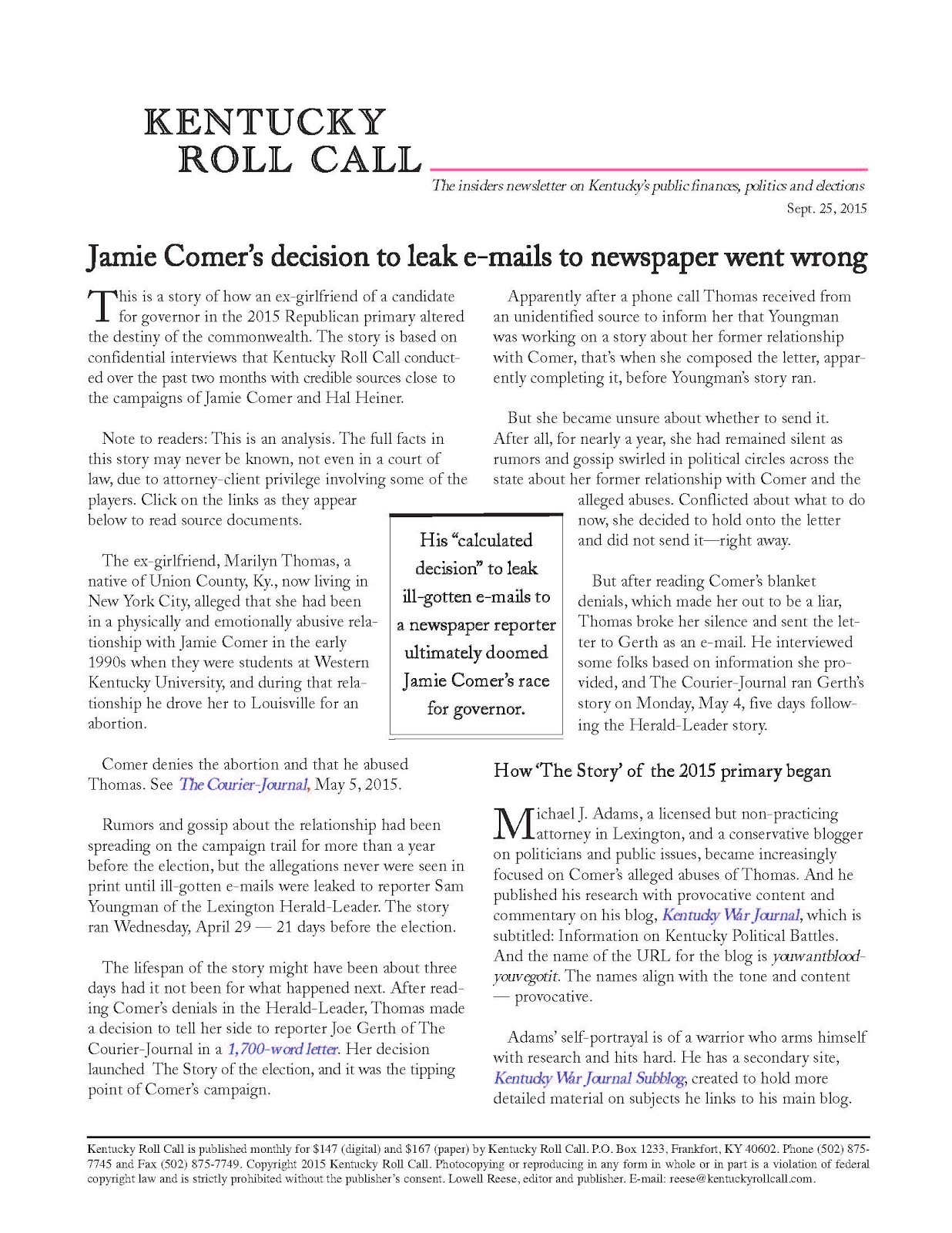The New York Times still
marks some stories as “Analysis.” You won’t find that word in Kentucky’s two
main papers anymore. The old school of journalism is dead at the Lexington
Herald Leader — and also The Courier-Journal, by the way. They purposely and consistently
blur the line between news and opinion. As I said in my editorial below, “Opinion
creeps from the editorial page to the news pages in silent steps” Well, that
was written in 1998. Today, opinions don’t creep off their assigned spaces —
they run wild, more of less without barriers, because editors allow it, and
seemingly encourage it.
I’ve seen no better example
than the story on the front page, above the fold, in today’s Lexington Herald
Leader. Read it here, http://ow.ly/TGV6J
The headline reads: “Whether
he knew or not, Pitino has to go.” The subhead was: “It’s time for coach to put
the program ahead of himself.”
And the very first sentence
of the story: “Rick Pitino has to go.” A short, one-sentence paragraph.
The writer’s opinion
continued dominated paragraph two: “That’s clear now. It doesn’t matter if the
Louisville basketball coach didn’t know. He should have known. It’s his
program. It’s his responsibility to know.” The whole story goes that way —
clearly an editorial on the front page masquerading as news.
Peter Baniak, are you on
vacation? Do you have no shame? Running editorials on the front page! It shows
a complete disrespect for the readers.
Today it’s about sports; tomorrow
it could about a politician that certain people at the paper don’t like.
The following is an editorial I wrote on this subject.
It ran June 30,1998, in The Kentucky Gazette.
Editorial opinion creeps unnoticed to front page
One of the amazing myths in American
society is that newspapers are impartial public servants. Newspapers are
neither impartial, nor public servants. They are businesses out to make money
by gathering information about people and selling it, while at the same time
receiving additional bucks from people who pay to have information printed
about themselves. It’s strictly business — news and advertising — and there’s
not much benevolence about it. Quite to the contrary, newspapers that have
achieved institutional status, like The Courier-Journal and Lexington
Herald-Leader, are used as instruments to mold society to the image of what the
editors think society ought to be — which, for the C-J and Herald, is liberal.
The late J. Ed McConnell said a person should gamble a
little every day because, “You might be walking around lucky and not even know
it.” Well, the newspapers you read every day may be liberal (or conservative)
to the bone — not just on the editorial page. But they handle it with such
finesse, you might not even know it.
Another myth about newspapers is that opinions stay on the
editorial page. They don’t. Opinion creeps from the editorial page to the news
pages in silent steps. One way is story selection. Choosing what stories to
write about is, in fact, an editorial statement. Thus, the doctrine of editors
is presented to the public on a daily basis...unnoticed with the news. And it’s
not co-incidental. The editors know it. A recent example is the controversial
series of stories by The Courier-Journal on coal dust sampling — clearly a
massive editorial.
The newspaper industry has a name for stealth editorial
statements masquerading on news pages: it’s called civic journalism. Or, some
call it democracy-enhancing journalism, because the aim, in the words of a
co-founder, is to “help public life go well by reengaging people in it.” In
other words, instead of explaining the community, convene it; instead of
exploring the issues, solve them; instead of exposing wrongs, campaign against
them.
Max Frankel, the former executive editor of The New York
Times, said, “The ardent civic journalists of today are not content to tell it
like it is, they want to tell it and fix it all at once.” Knight-Ridder and
Gannett — the owners of the Herald-Leader and Courier-Journal, respectively — are
adherents and practitioners of democracy-enhancing journalism.
In addition to the editorial page and story selections, a
third way that newspapers color themselves is through the biases of writers —
all of whom have beliefs that find their way into stories. Writers are always
visible just behind their words. They don’t plainly slant the news; that would
be unfair and unprofessional. What happens is that all stories are written with
stresses, colorations and emphasis that favor a writer’s view about “public
life going well.”
As language passes through a writer’s mind something happens
akin to bees making honey. As described by naturalist John Burroughs
(1837-1921): “The hive bee does not get honey from the flowers; honey is a
product of the bee. What she gets from the flowers is mainly sweet or nectar;
this she puts through a process of her own, and to it adds a minute drop of her
own secretion of formic acid. It is this special personal contribution that
converts the nectar into honey.” And writers contribute minute doses of
attitude — shades, colors and accents — that turn ordinary news into unnoticed
commentary.
The influence of the state’s two largest newspapers is
tremendous, but not as profound as commonly perceived. As the numbers printed
by the Gazette in this edition show, the Courier-Journal’s circulation outside
Jefferson County penetrates just 4.7 percent of the households in Kentucky; and
the Herald-Leader’s circulation outside Fayette County penetrates just 4.9
percent. But more importantly, they are read by movers and shakers and
decision-makers. And the multiplier effect is enormous: AP rewrites the papers’
stories for its members; and, consequently, TV and radio broadcasters rip and
read primarily from the state’s two dominate printcasters.
It’s too bad that the state’s news mechanism is controlled
by out-of-state-owned companies whose philosophies on public life are counter
to most Kentuckians. Long live the First Amendment. But in the long-term, the
news media can be more dangerous than politicians.
— Lowell Reese, publisher





